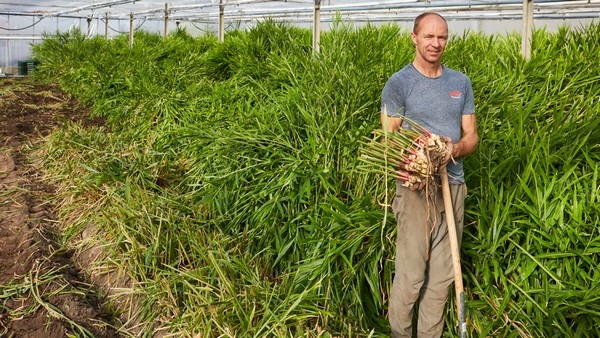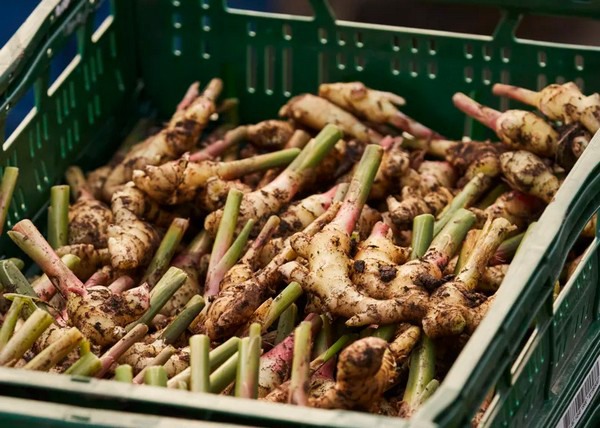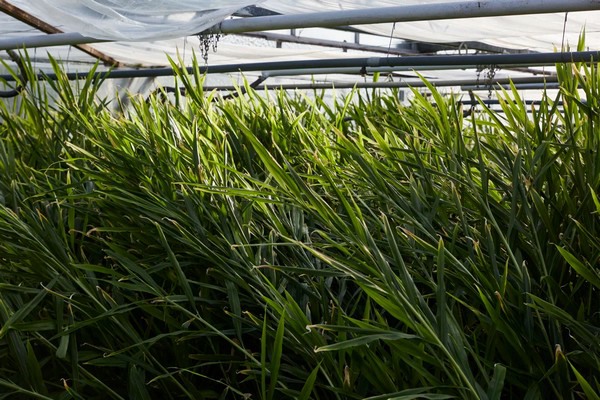Last year was the first time Belgian-grown ginger was on shop shelves and in Cru's experiential markets. The Belgian ginger was provided by West Flanders salad grower Bart Pynnebrouck. Now, the grower also supplies turmeric. The pilot project will be followed up. Belgian ginger is the result of a collaboration between Colruyt Group, REO Veiling, and the Provincial Experimentation Centre for Vegetable Production.
The West Flanders lettuce grower planted some 1,200 m² of ginger. With a row of 50 m² of turmeric added, the group is now providing a new Belgian first. Those locally grown ginger and turmeric have been on the shelves at Cru and OKay since last weekend.

Extended due to success
Exactly one year ago, Colruyt Group sold Belgian ginger for the first time. The greenhouses of the trial center in Kruishoutem contained 40 m² of ginger plants, yielding a harvest of 140 kg of fresh ginger. This was offered for sale in Cru's experiential markets and sold out in just two weeks. "The early Belgian ginger is tastier and juicier, contains less fiber, and is obviously a lot fresher than the imported version. And that clearly appealed to customers. Not only was the ginger sold out very quickly, but the demand for fresh ginger continued in the following weeks. So we went looking for a partner who wanted to grow Belgian early ginger on a larger scale," says Ward Steenackers, member of the Colruyt Group's food innovation team.
From lettuce greenhouse to tropical rainforest
Colruyt Group found that partner in Bart Pynnebrouck, a horticulturist from Oostnieuwkerke in West Flanders. Bart mainly grows lettuce and beans that end up on Colruyt and OKay shop shelves via the REO Veiling. Ginger is proving to be a good complementary crop. "Outdoor lettuce cultivation has been losing popularity for several years. For growers who have invested in this and have empty greenhouses, growing ginger can be a profitable alternative," explains Jan Schockaert, head of fruit purchasing at Colruyt Group.
"We were pleasantly surprised by Colruyt Group's project proposal and therefore jumped on the bandwagon with full enthusiasm. By growing ginger and turmeric, we promote our crop rotation and remain profitable for longer. Moreover, in this way, we actively contribute to experimenting with traditionally more exotic crops in Belgium. An example of innovation that we are only too happy to help test," agrees Bart Pynnebrouck.

The grower planted 1,200 m² of ginger this spring. The first part, some 800 kilos of fresh ginger, was harvested at the beginning of October. Three more harvests will follow in the coming weeks. In total, the grower is aiming for a yield of 4,000 kilos of early Belgian ginger. Because harvesting takes place when the leaves of the ginger plant are still nice and green, and the greenhouse resembles a tropical rainforest, the ginger does not get a chance to harden off or form a skin, so the result is more aromatic and contains no fiber but more juice. In addition, Bart Pynnebrouck embarked on another innovative cultivation: he planted a 50 m² row of turmeric, a first in Belgium.
The fresh ginger has been sold since this weekend in Cru's four experiential markets and in more than 140 OKay neighborhood supermarkets. Due to limited volume, the turmeric will only be available at Cru. Also new this year is that about a quarter of the freshly harvested ginger will be processed into new products. Juice maker JusJus, for instance, will start working with Belgian ginger, offering shots of fresh ginger, ginger-tumeric, and ginger-orange from this weekend. From the end of October, pear-ginger jam, ginger syrup, and pickled ginger made by supplier Pipaillon will join Cru's range.
Local and sustainable cultivation with a future
Ginger and turmeric traditionally come mainly from China, Peru, and Brazil, giving them a relatively large ecological footprint. Colruyt Group, therefore, sees numerous advantages in growing ginger locally. A short chain is positive for the environment, requiring less transport and, therefore, less CO2 emissions. The grower also benefits from extra cultivation to make optimal use of his greenhouses. Because a minimum of raw materials and no pesticides are used, and energy consumption and heating costs are kept as low as possible, this is a profitable crop. Finally, ginger is a popular product, with more and more customers putting it in their shopping carts. Offering them a Belgian variant, thus increasing the share of Belgian products on the shelves, is a major plus for Colruyt Group.
Belgium still has a lot to learn about ginger cultivation, but the conviction and ambition are there. Ward Steenackers confirms: "Together with REO Veiling, we are looking at how to expand the cultivation of Belgian ginger and how to get more growers enthusiastic. Today we still want to learn a lot about which varieties do well here, how we can automate the harvest and how we can store ginger so we can extend the Belgian season. With turmeric, we are now taking our first steps. The aim is to see if it can be done at all in Belgium."

Source text and photos: Colruyt
